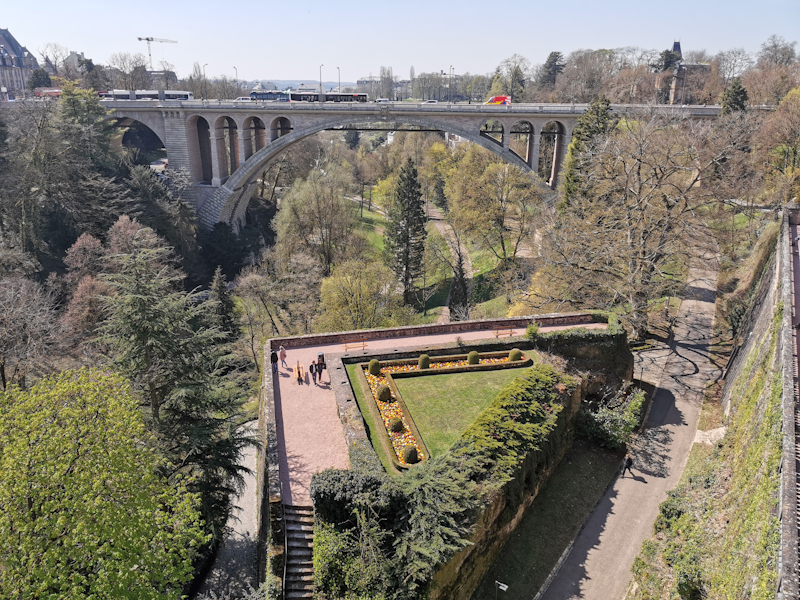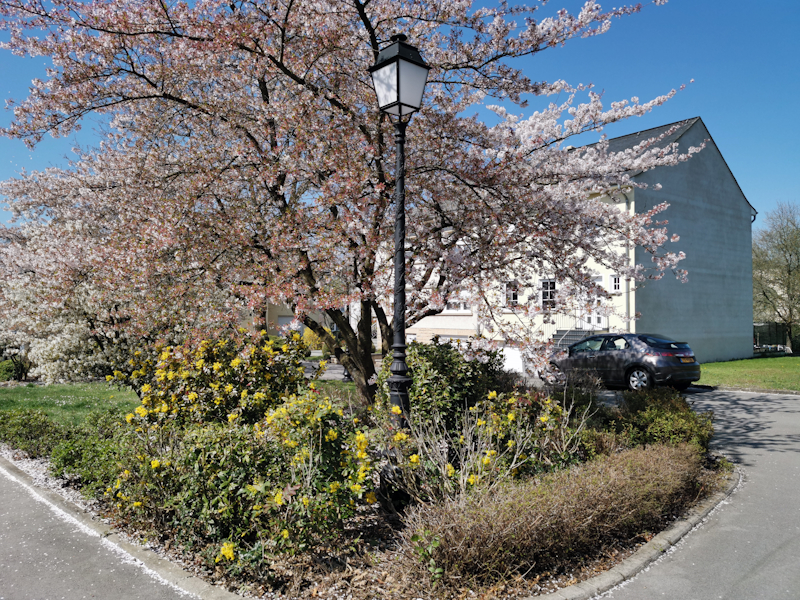The Huawei P30 & P30 Pro Reviews: Photography Enhanced
by Andrei Frumusanu on April 18, 2019 9:00 AM EST- Posted in
- Mobile
- Smartphones
- Huawei
- P30
- P30 Pro
Camera - Daylight Evaluation: Dynamic Range & Detail

[ P30 Pro ] - [ P30 ]
[ P20 Pro ] - [ P20 ]
[ Mate 20 Pro ] - [ S10+ (S) ]
[ S10+ (E) ] - [ S9+ (S) ] - [ G8 ]
[ G7 ] - [ V40 ] - [ View20 ]
[ OnePlus 6T ] - [ Pixel 3 ] - [ iPhone XS ]
Between the four Huawei 40MP sensor phones, the P30 Pro, P30, P20 Pro and Mate 20 Pro all produced vastly different results in their 10MP auto mode. The P30 Pro here produced a quite washed out image which was too desaturated, the P30 on the other hand was nearer to the actual scene. Both results have very different HDR processing compared to the P20 Pro which had a lot stronger processing going for it. The P30s produced more natural luminance gradients with less HDR artefacts.
Looking at the native 40MP results, all the phones have too dark results as the sensors lack dynamic range in this mode. What is also evident is that both the P30 units have trouble with resolving detail as well as the P20 Pro or the Mate 20 Pro. On one hand part of this is explained by the new optics with the wider aperture, particular some shots of the P30 Pro we see the shallower depth of field affecting details. On the other hand, this loss of detail is even present within the focal plane, and here the only explanation I have is that it’s either due to processing or simply the new RYYB sensor which isn’t able to achieve the same colour spatial resolution as the previous generation Bayer sensor.

[ P30 Pro ] - [ P30 ]
[ P20 Pro ] - [ P20 ] - [ Mate 20 Pro ]
[ S10+ (S) ] - [ S10+ (E) ] - [ S9+ (S) ]
[ G8 ] - [ G7 ] - [ V40 ]
[ View20 ] - [ OnePlus 6T ] - [ Pixel 3 ] - [ iPhone XS ]
This next scene with the cherry tree better demonstrates the weaknesses of the optics on the P30 Pro. Its wider aperture of f/1.6 versus the f/1.8 is visible in the outer parts of the image as things get blurred out because of chromatic aberrations. Again, this scene was extremely bright with the sun directly overhead. Both P30s in their native resolution showcase worse optics than the Mate 20 Pro which is able to get clean details throughout the scene without any haze. Again some of the loss in detail can’t be explained just by the optics, and here I think it’s again the sensor which might have a worse DTI implementation has Huawei’s previous 40MP units. These issues aren’t immediately visible in the 10MP shots as things become quite small.
This is a good opportunity to talk about Huawei’s Master AI mode; this had existed in past flagships in various iterations, but now Huawei has finally put a UI button switch directly in the camera interface. Last year this mode was a complete disaster with cartoonish contract and vignette effects, however starting with the Mate 20s it was a lot more toned down. For the P30s, I’ve found that in the vast majority of times it’s beneficial, such as in this sot a slightly bluer sky and a little brighter highlights.

[ P30 Pro ] - [ P30 ]
[ P20 Pro ] - [ P20 ] - [ Mate 20 Pro ]
[ S10+ (S) ] - [ S10+ (E) ] - [ S9+ (S) ]
[ G8 ] - [ G7 ] - [ V40 ]
[ View20 ] - [ OnePlus 6T ] - [ Pixel 3 ] - [ iPhone XS ]
This road scene again shows the optics differences between the P30 Pro, P30 and Mate 20 Pro. The larger aperture of the P30 Pro results in hazy details around the centre of the image, while the P30 doesn’t suffer as much. Still the Mate 20 Pro is far ahead of both in the optics and remains extremely sharp.
Again in the default mode the exposures are a bit too bland for the fact that the sun is directly overhead at noon – the AI mode again brings back a bit of saturation and highlights. Samsung and LG do a lot better here.

[ P30 Pro ] - [ P30 ]
[ P20 Pro ] - [ P20 ]
[ Mate 20 Pro ] - [ S10+ (S) ]
[ S10+ (E) ] - [ S9+ (S) ] - [ G8 ]
[ G7 ] - [ V40 ] - [ View20 ]
[ OnePlus 6T ] - [ Pixel 3 ] - [ iPhone XS ]

[ P30 Pro ] - [ P30 ]
[ P20 Pro ] - [ P20 ] - [ Mate 20 Pro ]
[ S10+ (S) ] - [ S10+ (E) ] - [ S9+ (S) ]
[ G8 ] - [ G7 ] - [ V40 ] - [ View20 ]
[ OnePlus 6T ] - [ Pixel 3 ] - [ iPhone XS ]
In the last scene we again see evident shallow depth of field of both units, with the P30’s focal plane being slightly nearer in this autofocus shot. On the P30 Pro you need to be aware of the new optics, as they can be a double-edged sword. On one hand it can give you natural blurring, but in some cases if you do not want the effect, you can’t do nothing about it, as opposed to say Samsung’s dual-aperture main camera.
The 40MP mode here is useless as while it captures a lot of detail, the dynamic range is severely lacking. Also this scene showcases the bad aspects of the AI mode; colours get far too saturated and unnatural.
P30 Pro & P30 Daylight Evaluation Conclusion
Overall, Huawei’s strategy in their camera hasn’t changed and what we’re seeing in the P30 Pro and P30 in terms of daylight capture continues the trends we saw in the P20s and Mate 20s.
In terms of versatility in different scenarios, the P30s are king. The inclusion of the trifecta of wide angle, regular and telephoto lenses means that you’ll be able to have the right camera at hand in the vast majority of cases. However this was also true for the Mate 20 released late last year.
So how do the P30’s differentiate? Well the P30 doesn’t try to do things much differently, and its camera setup is in line with what we found on the P20 Pro and Mate 20 Pro. This is not to say it’s bad, and the 3x telephoto zoom module is still unique to Huawei.
The P30 Pro’s 5x optical zoom module tries to do something special, and yes indeed it can capture things farther than any other phone out there. I do however have concerns on just exactly how useful this is in everyday usage, as I rarely find myself needing to zoom in quite that far. At 2x digital magnification/crop the P30s still hold up against the optical 2x modules because of the 40MP sensors, however going to 3x zoom we find that the P30 Pro finds itself in a quality gap until you go further to 5x. The bigger concern here is the f/3.4 aperture lens of the new module, and it’s evident that while it gets a lot of detail, its exposure isn’t quite the best.
The wide angle modules on both phones are great, but like on the Mate 20s, the Pro version has a better sensor that is able to capture more detail as well as have better dynamic range.
Processing on the P30s has changed a lot compared to the Mate 20s, however this is not always for a benefit. Sometimes HDR processing is a regression over the Mate 20s, however most of the time it does a better job. Colour rendition is also something the P30s sometimes seem to struggle and I did find some shots a tad too undersaturated, something that in the vast majority of cases is fixed by enabling the AI mode.
Speaking of the AI mode, compared to last year’s P20s, it’s a gigantic leap. This year it’s much more subtle and in the vast majority of cases it’s for the benefit of the scene. It’s only on rare occasions where it does go overboard.
Finally, the main optics of the P30 Pro and P30 feel like a slight disappointment to me. Particularly in the 40MP modes it’s evident that the lenses have seen downgrades compared to what we had in the Mate 20 Pro. The P30 Pro’s large f/1.6 aperture suffers more than the f/1.8 unit of the P30. In 10MP mode this is less immediately visible, however upon closer inspection it does result in less detail even in this mode.
I’m not certain if it’s due to the processing or the sensor, but even within the focal plane we’re seeing less detail sharpness. I very much think this is partly due to the new RYYB sensor which seemingly has lesser DTI (deep trench isolation) between the pixels.
Overall for daylight pictures, I come to the same conclusion I had on the P20 Pro, Mate 20 Pro and View20: These high megapixel sensors do not always achieve the best quality in well-lit scenarios. Huawei also needs to work on the composition consistency between the different camera sensors, there’s too many scenarios where the wide-angle, main camera as well as the zoom lens produce much too different results.










85 Comments
View All Comments
Quantumz0d - Thursday, April 18, 2019 - link
Good camera review, their auto mode looks good at night but the low light photography in smartphone arena is heavily faked. Be it Google insane algorithm for creating unnatural light or th damn Huawei night mode with HW. I think its too fake and perhaps they do have advantages in some situations but going from a dark room to a lit room is bad in my book.Next up the stupid curved glass copy they did from Samsung needs shaming. Plus its a waste that distortion of image is horrible and the damn construction is weak, see Jerry rig for it.
Then the worst parts - NanoSD ? WTF, please call them out for this, proprietary storages ? That's anti consumer, I use my SGS with 200GB SD card yes the 10Yr old phone with replaced battery and Fat32 works. And same in my iPods and V30S, and it works in PC without any stupid gimmicks or bloat.
Finally Andrei, I know your contribution to Samsung Exynos S9 disaster, it was only possible because it allows Bootloader unlock. That's the most powerful feature of Android and its principles of GNU GPL.
This Huawei junk is blocking access to that officially and in India I read the service centers demand DL for their Honor subsidiary, XDA portal people sold their soul to Huawei and OnePlus now their contract expired for OP and Huawei I guess. This is another massive hole in Huawei devices. I have every doubt about the firmware and SoCs from this CPC company I would really wish to have a Bootloader unlock for all their portfolio subsidiaries and themselves. Its bad, no ownership choice is horrible given how their EMUI blocks lot of stuff and notorious for its control over background processes.
You should include that in your reviews, please.
Thank you.
Quantumz0d - Thursday, April 18, 2019 - link
Also thank you for mentioning the 3.5mm jack and the stupid mono speaker in 2019. LG is Audio champion since a long time and hopefully they will retain that with their top class ESS Sabre implementation moving ahead. Also to note, LG and their new G8 has zero bumps which is a feat along with the Crystal Sound they call. Looking forward for piece.zeeBomb - Thursday, April 18, 2019 - link
You guys should take a look of MrWhoseTheBoss and his videos about this amazing phone. Such a shame you can't get it in carriers in the Americas, but man oh man.Ian Cutress - Thursday, April 18, 2019 - link
>You guys should take a look of MrWhoseTheBoss and his videos about this amazing phone.Any specific reason? You haven't exactly said why.
zeeBomb - Monday, May 6, 2019 - link
My bad. Sorry for the late reply too, he talks primarily about the sensor of the P30 Pro and its usefulness in Low Light. Just a suggestion to take a look.bogda - Thursday, April 18, 2019 - link
I think this statement: "...Huawei continues the senseless design choice of including a headphone jack on the smaller model while skipping it on the larger and more expensive P30 Pro.", makes much more sense if it is changed just a little bit into:"Huawei continues the senseless design choice of skipping a headphone jack on larger and more expensive P30 Pro while including it on the smaller model."
Awful - Thursday, April 18, 2019 - link
Great review but still missing half the picture when it comes to the camera. Time-of-flight sensor? Graduated blur based on depth map? Portrait/face lighting? People are the most photographed and most interesting subjects. Even if it's a mannequin with a wig for repeatability!s.yu - Friday, April 19, 2019 - link
Portrait lighting has been gimmicky for a few generations now. Regarding ToF, IIRC only the Nokia 9 has the proper implementation. Still there are pixel grade deviations and some people aren't satisfied. Personally if I were to add fake bokeh that precision would be enough for me.Awful - Saturday, April 20, 2019 - link
Yeah, they weren't really meant to be separate concerns- they're all factors contributing to portraits. I.e. how the exposure is chosen, how the depth is mapped to the bokeh/blue, how edge detection is done and masked for blurring, how AI/ML is used to make adjustments etc. All great computational photography stuff...that this review is silent on.Lau_Tech - Friday, April 19, 2019 - link
Hi Andrei, as a s10 exynos owner, was interested to see your updated comparison pics between the snapdragon and exynos. Looking at the pics from ur S10 review and now, it seems to me that the gap has closed substantially especially in daytime photos? What do you think?